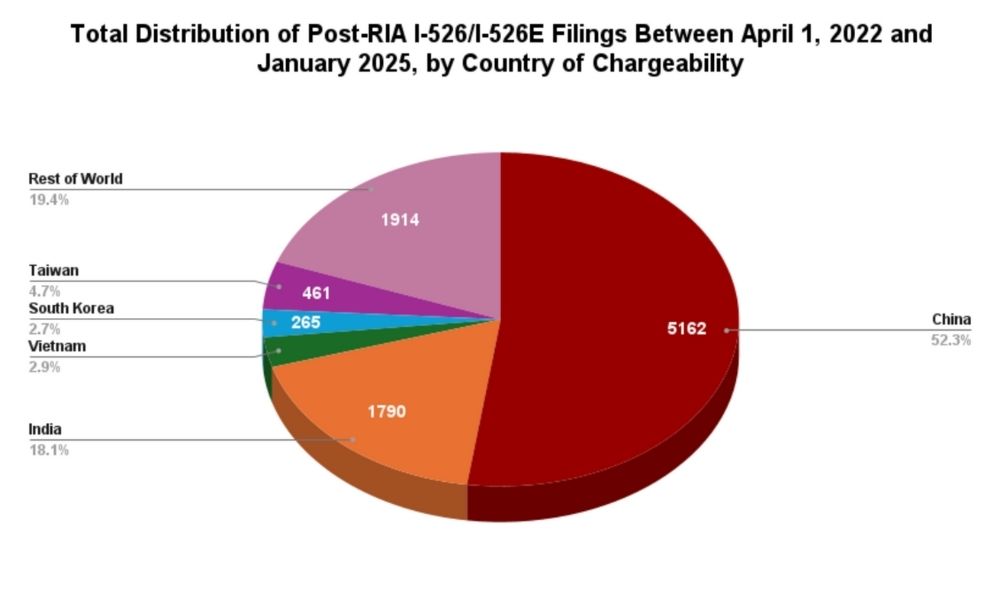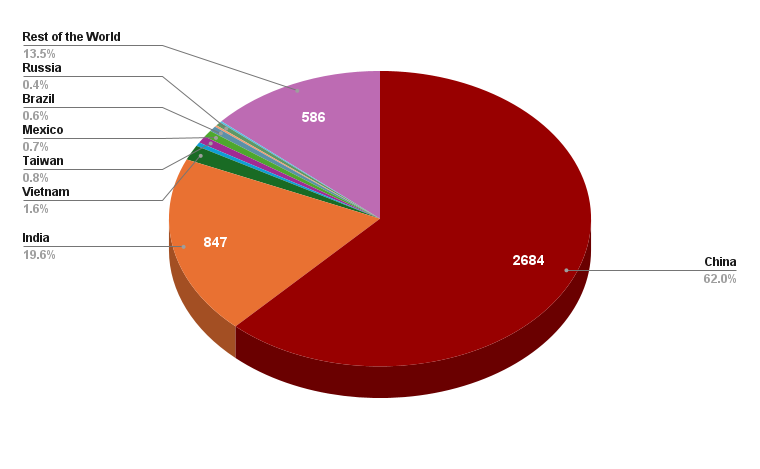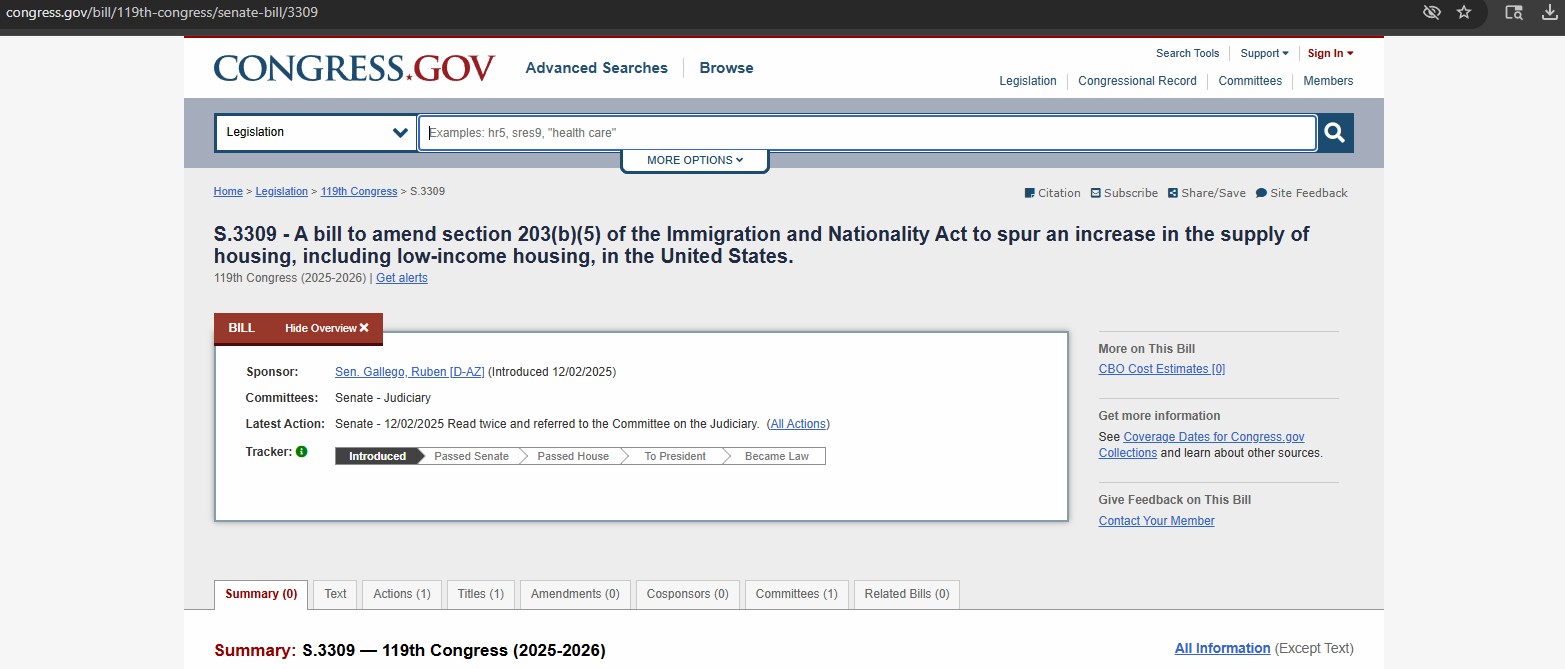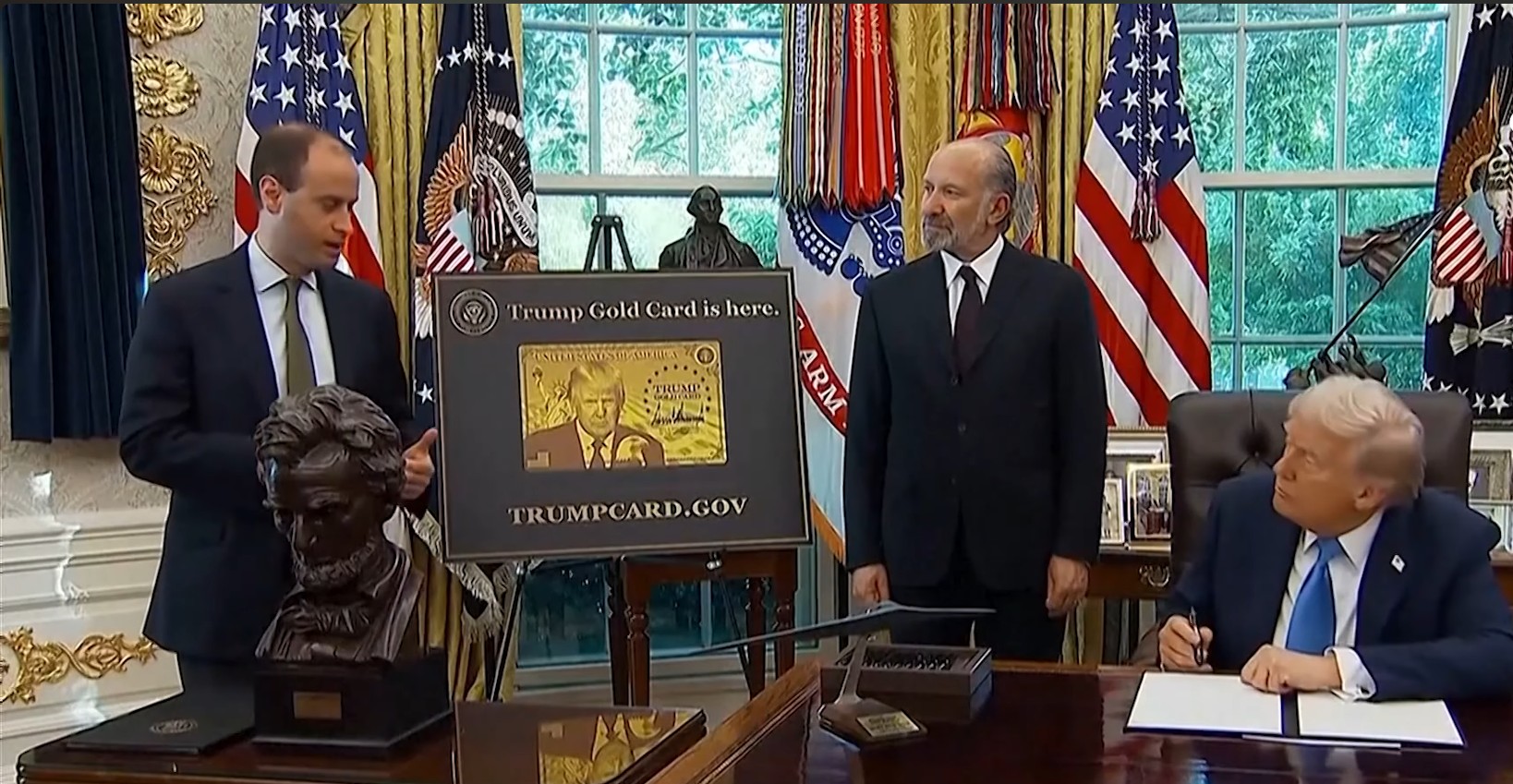AIIA FOIA Series: Updated I-526E Inventory Statistics for January 2025
27th April, 2025
USCIS FOIA data obtained by AIIA shows post-RIA EB-5 demand far exceeds annual visa limits—about 10× for high unemployment and 4× for rural—creating long potential wait times, especially for China and India. We ask you to consider donating to sustain FOIA litigation and advocacy for investor transparency.

Background: As part of our mission to advocate for EB-5 investors, AIIA regularly files Freedom of Information Act (FOIA) requests for information from USCIS on topics that affect the EB-5 immigrant investor community. Because USCIS does not provide timely response to FOIA requests, AIIA regularly litigates against them to compel the agency to respond. In response to our recent lawsuit, USCIS has provided us with the filing, approval, and denial data for post-RIA investors as of January 2025. This is a crucial set of data for immigrant investors to determine the wait times to receive their green cards. We ask that you consider donating to help us continue to pursue these efforts. AIIA Members may request a full copy of government responses to AIIA FOIA requests by reaching out to us through our contact form. AIIA is grateful to Alexandra George of the Galati Law Firm for leading the FOIA litigation effort against USCIS in order to obtain this data.
(来自中国的读者们可以通过以下链接访问AIIA微信公众号上发表的本文翻译: https://mp.weixin.qq.com/s/sByvBRo5uKSdhuN9GJ2t8Q)
We have previously reported the official data we received from USCIS by filing multiple lawsuits against the agency. This includes detailed data on I-526 and I-526E receipts from April 2023, November 2023 and July 2024. USCIS has now provided AIIA with a report through January 31, 2025, with data queried by the USCIS Office of Performance and Quality in February 2025. The updated data contains the distribution of I-526 and I-526E receipts by TEA category and country of chargeability, which is crucial for understanding visa backlogs and estimating waiting times in the reserved visa categories.
The data provided by USCIS to AIIA is the most complete post-RIA I-526E report to date because (1) the report provides receipts by month, which is important for showing trends, and (2) the report provides data that USCIS queried recently, in February 2025. The query date is important, because USCIS takes time to enter receipts into the database. The report that USCIS provided to AIIA states that 9,878 petitions (i.e., I-526 and I-526E) were filed in total between April 2022 and January 2025.
Total number of I-526/I-526E petitions filed between April 1, 2022 and January 31, 2025 by TEA category and country of chargeability (latest statistics as per USCIS data queried February 2025 in response to AIIA FOIA request)
| China | India | Rest of World | Total | % Total | |
| Rural | 2,684 | 847 | 798 | 4,329 | 44% |
| High Unemployment | 2,380 | 883 | 1,928 | 5,191 | 53% |
| Infrastructure | 0% | ||||
| Other | 98 | 60 | 200 | 358 | 4% |
| Total | 5,162 | 1,790 | 2,926 | 9,878 | 100% |
| % Total | 52% | 18% | 30% | 100% |
By the end of January 2025, a total of 5,191 investors had filed I-526/I-526E petitions in the high unemployment (HUA) set-aside category, and 4,329 investors had filed petitions in the rural category. These figures entail a demand of approximately 10,400 HUA visas and 8,700 rural visas (taking into account the estimated number of derivative petitions by dependents , such as wives and children, and denial rates). The figures far outstrip the statutory annual visa availability of 1,000 high unemployment set-aside visas and 2,000 rural set-aside visas.
Demand Trend by TEA Category
Global Post-RIA I-526/I-526E Filing Trends, by Visa Set-Aside Categories

The above chart shows that rural petitions have steadily narrowed the gap with HUA petitions since our previous update in July 2024.
Demand Trend by Country
Global Post-RIA I-526/I-526E Filing Trend, by Country of Changeability for HUA category

Global Post-RIA I-526/I-526E Filing Trend, by Country of Changeability for Rural category

The petition trends across countries have started to stabilize after the turbulence of March 2024 caused by the fee increase, with Mainland China and India resuming their respective normative petition volumes in more recent months. The petitions filed by all other countries have remained robust post-March 2024 as well.
China Rural vs HUA
Rural vs High Unemployment I-526/I-526E Filings from Mainland China

India Rural vs HUA
Rural vs High Unemployment I-526/I-526E Filings from India

Comparison of EB-5 Demand in the Top Markets
Distribution of I-526E Filings for the Rural Category (April 2022 to January 2025)

Distribution of I-526E Filings for the High Unemployment Category (April 2022 to January 2025)

The proportions of petitions coming from both Mainland China and India across both the Rural and the High Unemployment categories have remained stable since the last FOIA data release.
What does this data mean for the invisible visa backlog?
As of January 2025, there was demand for 10 times as many High Unemployment visas and 4 times as many Rural visas, compared to their respective annual visa supply numbers.
| High Unemployment | Rural | |
| Actual investor I-526 / I-526E filed 2022 to Jan 2025 | 5,191 | 4,329 |
| Estimated average visa demand per I-526/I-526E filed | 2 | 2 |
| Estimated pipeline visa demand as of Jan 2025 | 10,382 | 8,658 |
| Base Annual Visa Supply | 1,000 | 2,000 |
| Worldwide pipeline demand / Base Annual Visa Supply | 10.4 x | 4.3 x |
If visas were issued first-in-first-out (FIFO) with no country limit, it would mean about a 10-year wait time for high unemployment and 4-year wait time Rural for investors with priority dates after January 2025. Since there are country limits on visa allocation, actual visa wait times could be much less for new investors from the Rest of the World and much greater for new investors from Mainland China and India.
Take the example of an Indian investor today considering a TEA investment. Should he expect to wait 5 to 10 years or more for a visa, considering the number of rural and high unemployment investors already queued up? The answer would be “Yes,” if TEA investors could only get TEA visas. However, a TEA investor may also choose after I-526E approval to be allocated an Unreserved visa. The Unreserved category also has backlogs, but the Unreserved pre-RIA backlog for India-born petitioners may be cleared within 5 years – making it possibly the soonest-available visa for India-born investors in 2025 regardless of whether they choose to invest in a rural or high unemployment TEA. If the China pre-RIA Unreserved backlog may possibly be cleared in about 8 years, then the Unreserved category may also be a fallback for China-born TEA investors. The backlog situation and visa wait times for China and India TEA investors can also be improved if many Rest of World TEA investors elect to take Unreserved visas following I-526E approval. Otherwise, if TEA investors from China and India were actually limited by TEA category and country caps, then wait times would be astronomical, given that pipeline visa demand from China and India far exceeds 7% of rural and high unemployment visas.
In Summary
The major highlights we can see from this dataset are that 1) Demand for EB-5 visas has increased since April 2024, within every TEA category and every country group; 2) Demand for Rural TEA visas has consistently outpaced demand for high unemployment; and 3) China continued to show the strongest demand growth. By studying the monthly visa issuance data and the fact that only 3% of the visas for the year have been issued, it is very likely that the visa bulletin will remain current for the rest of the year. We can make this prediction with some confidence given the fact that only 351 HUA and 1,126 rural petitions have been approved as of January 2025. This topic will be explored further in a future blog post.
As a nonprofit organization, AIIA invests significant time and resources in acquiring, analyzing, and disseminating this data. We rely solely on donations to sustain our efforts, including funding FOIA litigation, lobbying, and daily operations. We urge anyone who values our work to enhance transparency in the EB-5 program to consider supporting us by making a donation or membership contribution. Your support is vital in ensuring that we can continue to advocate for transparency and equity in the EB-5 program, benefiting investors and industry professionals alike.

Stay Up To Date With AIIA
Join our newsletter to stay up to date on EB-5 updates.
By subscribing you agree to with our Privacy Policy and provide consent to receive updates from our company.
Recommended Resources

The Issue of Aging Out in EB-5
The Child Status Protection Act (CSPA) helps freeze a child’s age on EB-5 petitions, but long visa backlogs still risk...
Read More
The Sale of EB-5 Securities Offerings
EB-5 securities sales often use Regulation D (U.S. investors) and Regulation S (foreign investors) exemptions to avoid SEC registration while...
Read More
Choosing between Direct vs Regional Center EB-5 financing
Direct EB-5 suits single investors creating direct jobs; Regional Center EB-5 pools multiple investors, counting direct and indirect jobs for...
Read MoreRecent Blog Posts

We Congratulate Senator Gallego for New Legislation that Leverages the EB-5 Program to Build Affordable Housing
Sen. Gallego's EB-5 bill mobilizes foreign capital to build affordable housing. This collaboration has boosted AIIA's Congressional ties & credibility...
Learn More
We Won The EB-5 Fee Increase Lawsuit
AIIA successfully won its lawsuit against USCIS’s April 2024 EB-5 fee increases, with a federal judge ruling that the agency...
Learn More
One Year Left to Invest in a EB-5 Regional Center Project
AIIA warns that EB-5 Regional Center investors will lose protection after Sept. 30, 2026 unless they file I-526E petitions before...
Learn More
Trump Gold Card: A New Green Card Pathway Competing with EB-5
Trump’s new $1M “Gold Card” visa plan competes directly with EB-5 and raises serious legal concerns, as it lacks statutory...
Learn MoreGet In Touch With Us
If you have any questions, inquiries, or collaboration proposals, please don’t hesitate to reach out to us.

Responses (0)